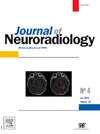Efficacy and safety of the Neuroform Atlas stent for bifurcation type unruptured cerebral aneurysms: Comparison of single versus Y stents with propensity score matching
IF 3.3
3区 医学
Q2 CLINICAL NEUROLOGY
引用次数: 0
Abstract
Background and Purpose
Y-stent-assisted coiling (Y-SAC) using two stents can provide adequate coverage of the aneurysm neck even in wide-neck bifurcation-type aneurysms, but whether it is more effective and safer than single-stent-assisted coiling (S-SAC) remains unclear. The purpose of this study was to investigate the efficacy and safety of Y-SAC with the Neuroform Atlas stent for bifurcation-type unruptured cerebral aneurysms (UCAs).
Materials and Methods
A total of 186 bifurcation-type UCAs treated with the Neuroform Atlas stent were retrospectively reviewed. The aneurysms were divided into Y-SAC and S-SAC groups. Angiographic occlusion status and complication rates were analyzed using 1:2 propensity score matching.
Results
Of the 186 UCAs, 17 (9.1 %) were treated by Y-SAC. Propensity score matching was successful for 14 UCAs in the Y-SAC group and 28 UCAs in the S-SAC group. After propensity score matching, the Y-SAC group had a higher rate of complete occlusion immediately after treatment (71.4 % vs. 32.1 %, P = 0.023), a significantly higher volume embolization ratio (33.3 % [IQR: 30.4, 38.5] vs. 28.9 % [IQR: 24.1, 32.4], P = 0.03), and higher device and implant costs ($11,335 [IQR: $10,427, $13,894] vs. $9592 [IQR: $8211, $10,959], P = 0.002) compared to the S-SAC group. However, the rate of complete occlusion at one year (78.6 % vs. 64.3 %, P = 0.485) and the recanalization rate (14.3 % vs. 3.6 %, P = 0.254) did not differ significantly between the two groups. No significant differences in the incidences of any complications were found between the two groups.
Conclusions
Y-SAC did not improve the complete occlusion rate at one year or reduce the risk of recanalization compared with S-SAC. Given its procedural simplicity and cost-effectiveness, S-SAC may be the preferred strategy for embolizing bifurcation-type UCAs.

神经形态Atlas支架治疗分叉型未破裂脑动脉瘤的疗效和安全性:单支架与Y支架倾向评分匹配的比较
背景与目的:使用两个支架的y -支架辅助卷绕(Y-SAC)即使在宽颈分岔型动脉瘤中也能提供足够的动脉瘤颈部覆盖,但是否比单支架辅助卷绕(S-SAC)更有效和安全尚不清楚。本研究的目的是探讨Y-SAC联合神经形态Atlas支架治疗分叉型未破裂脑动脉瘤(UCAs)的疗效和安全性。材料与方法:回顾性分析应用Neuroform Atlas支架治疗的186例分叉型uca。动脉瘤分为Y-SAC组和S-SAC组。采用1:2倾向评分匹配分析血管造影闭塞状况和并发症发生率。结果:186例uca中,Y-SAC治疗17例(9.1%)。Y-SAC组14例uca和S-SAC组28例uca的倾向评分匹配成功。倾向评分匹配后,Y-SAC组治疗后立即完全闭塞率较高(71.4%比32.1%,P=0.023),体积栓塞率显著高于S-SAC组(33.3% [IQR: 30.4, 38.5]比28.9% [IQR: 24.1, 32.4], P=0.03),器械和种植体费用较高(11,335美元[IQR: 10,427美元,13,894美元]比9,592美元[IQR: 8,211美元,10,959美元],P=0.002)。然而,两组1年完全闭塞率(78.6% vs. 64.3%, P=0.485)和再通率(14.3% vs. 3.6%, P=0.254)无显著差异。两组患者并发症发生率无显著差异。结论:与S-SAC相比,Y-SAC不能提高1年完全闭塞率,也不能降低再通的风险。鉴于其程序简单和成本效益,S-SAC可能是栓塞分叉型uca的首选策略。
本文章由计算机程序翻译,如有差异,请以英文原文为准。
求助全文
约1分钟内获得全文
求助全文
来源期刊

Journal of Neuroradiology
医学-核医学
CiteScore
6.10
自引率
5.70%
发文量
142
审稿时长
6-12 weeks
期刊介绍:
The Journal of Neuroradiology is a peer-reviewed journal, publishing worldwide clinical and basic research in the field of diagnostic and Interventional neuroradiology, translational and molecular neuroimaging, and artificial intelligence in neuroradiology.
The Journal of Neuroradiology considers for publication articles, reviews, technical notes and letters to the editors (correspondence section), provided that the methodology and scientific content are of high quality, and that the results will have substantial clinical impact and/or physiological importance.
 求助内容:
求助内容: 应助结果提醒方式:
应助结果提醒方式:


